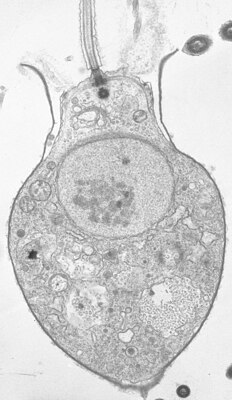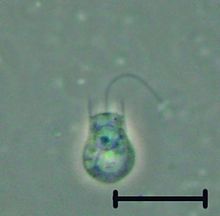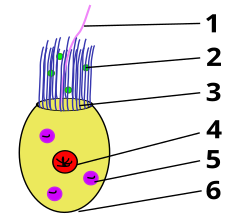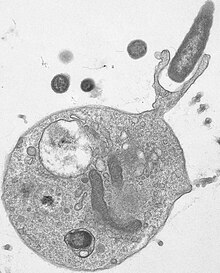Collared flagellates
| Collared flagellates | ||||||||||||
|---|---|---|---|---|---|---|---|---|---|---|---|---|

Salpingoeca sp. |
||||||||||||
| Systematics | ||||||||||||
|
||||||||||||
| Scientific name | ||||||||||||
| Choanomonada | ||||||||||||
| Kent , 1880 | ||||||||||||
| without rank | ||||||||||||
Collared flagellates (Choanomonada, also Choanoflagellata) are a group of unicellular organisms that are counted among the Holozoa . Due to their resemblance to the choanocytes of the sponges , the Choanomonada are regarded as the closest unicellular relatives of the multicellular animals.
features
Collared flagellates are comparatively small protists, usually up to 10 µm in size . A “collar” of 30 to 40 fine, thread-like cell processes ( microvilli ), which does not exist in this form in any other group of protists, and a single scourge in the center that protrudes beyond the collar are characteristic of them. A formerly existing second scourge was lost in the course of development history and can only be detected on the preserved kinetosome . The flagellum is used by free-swimming species such as Monosigma brevicollis to propel them and stuck species such as Codosigma botyoides to generate a current in order to feed food particles to the collar cells . A Golgi apparatus is located between the collar and the nucleus of the cell . The plasma contains mitochondria . The end of the cell opposite the flagellum can carry filipodia or form a stalk in sessile species.
The group of Acanthoecida forms a Lorica , a basket-like protective cover with rib-like, silicate-containing reinforcements. Many sessile species form thecae , extracellular, chalice- or jug-shaped, sometimes stalked cell envelopes.
Way of life
Collared flagellates occur either as stationary or as free-floating individuals or colonies in sea and fresh water. There are unicellular, free-swimming species such as Monosiga brevicollis , free-swimming colonies such as Salpingoeca rosetta, and colonies fixed to substrate such as Codosiga botrytis . They swim with a backward scourge (thrust scourge).
They feed on organic particles, especially bacteria floating in the water, which they catch by whirling them up to their collars with the movement of their flagella. The water with the food particles is moved from the outside to the inside like in a trap apparatus. The bacteria or other particles stick to the outside of the mucus-coated microvilli of the collar apparatus and migrate with the mucus to the base of the collar, where they are transported and digested in food vacuoles . The electron microscope image at the bottom right shows a collar flagellate eating food.
Many species are easy to cultivate and have a generation time of 6 to 8 hours. The reproduction occurs both asexually and sexually. Asexual reproduction through longitudinal division is most common . In the case of the marine eyelash animal Salpingoeca rosetta , it has been demonstrated that certain bacterial constituents trigger swarming and subsequent sexual reproduction.
Systematics
External system
The frilled flagellates form together with the multicellular animals (Metazoa) and some protozoa the taxon Holozoa :
| Amorphea |
|
||||||||||||||||||||||||||||||
|
|
Internal system
The collar flagellates represent one of the groups of the so-called Holozoa . They were traditionally divided into three further groups:
Later research results, however, led to the combination of the Monosigidae and the Salpingoecidae in only two groups:
Order Craspedida
15 genera
- Astrosiga : Kent, 1880-1882
- Codonocladium stone, 1878
- Codonosiga James-Clark, 1868

- Codosiga botrytis (stalk flagellate) occurs in stagnant water on aquatic plants. The flagellates sit individually or in groups at the tip of a stalk that is 2 to 10 times as long as the organism. The cell size is 8 - 30 µm. The organisms often attach themselves to the stalks of bells .
- Desmarella Kent, 1880-1882
- Monosiga Kent, 1880-1882
- Monosiga ovata (egg-shaped collar flagellate) is a solitary, spherical to uniform flagellate that sits directly or with a short stalk on a base. It can be found in stagnant inland waters on detritus, aquatic plants and sometimes sitting on plankton. The size is 5-16 µm. The flagellum is about 20 µm long.
- Monosiga fusiformis (spindle flagellate) lives as a unicellular organism and sits fixed on a base with its pointed rear end. It has a relatively large plasma collar and two contractile vacuoles. It prefers clean standing fresh water and often attaches itself to plankton.
- Phalansterium Norris, in Parker, 1982.
- Phalansterium digitatum (water finger) is a freshwater species that occurs in small stagnant bodies of water and between wet mosses. The organisms consist of finger-shaped, branched gelatinous columns at the ends of which sit one to four flagellates 17 μm in size. The 35 μm long flagella extend far beyond the jelly.
- Proterospongia Kent, 1880-1882
- Sphaeroeca Lauterborn, 1894
- Stylochromonas Norris, in Parker, 1982
- Aulomonas Lackey, 1942
- Choanoeca Ellis, 1930
- Diploeca Ellis, 1930
- Pachysoeca Ellis, 1930
-
Salpingoeca James-Clark, 1868
- Salpingoeca rosetta : sea creatures
- Stelexomonas Lackey, 1942
Order Acanthoecida
Norris, 1965, 31 genera
- Acanthocorbis Hara & Takahashi, 1984
- Acanthoeca Ellis, 1930
- Acanthoecopsis Leadbeater & Thomsen, 2000
- Amoenoscopa Hara & Takahashi, 1987
- Apheloecion Thomsen, 1983
- Bicosta Leadbeater, 1978
- Calliacantha Leadbeater, 1978
- Calotheca Thomsen & Moestrup, 1983
- Campyloacantha Hara & Takahashi, 1987
- Conion Thomsen, 1982
- Cosmoeca Thomsen, 1984
- Crinolina Thomsen, 1976
- Crucispina Espeland, 1986
- Diaphanoeca Ellis, 1930
- Diplotheca Valkanov, 1970
- Kakoeca Buck & Marchant, 1991
- Monocosta Thomsen, 1979
- Nannoeca Thomsen, 1988
- Parvicorbicula (Meunier, 1910) Deflandre, 1960
- Platypleura Thomsen, 1983
- Pleurasiga Schiller, 1925
- Polyfibula Manton, 1981
- Polyoeca Kent, 1880
- Saepicula Leadbeater, 1980
- Saroeca Thomsen, 1979
- Savillea (Ellis, 1930) Loeblich, 1967
- Spiraloecion Marchant & Perrin, 1986
- Sportelloeca Norris, in Parker, 1982
- Stephanacantha Thomsen, 1983
- Stephanoeca Ellis, 1930
- Syndetophyllum Thomsen & Moestrup, 1983
evolution
A crucial step in evolution was the transition from single cells to multicellular organisms , which happened several times. Higher plants, multicellular algae, fungi and animal metazoa have taken this step. The transition to multicellularity in animals was particularly striking because it marked the beginning of the so-called Cambrian Explosion , which led to the rapid emergence of most animal phyla of 530 million years ago. By comparing proteins, especially actin , α- tubulin and elongation factor la, it was found that both fungi and animal metazoans as a common ancestor a Opisthokonten had. The analysis of mitochondrial DNA showed that within the opisthokonts the collar flagellates are closest to the metazoa and here again to the sponges. This is also suggested by the morphology. The collar flagellate system of the collar flagellates is very likely homologous to that of the choanocytes of the sponges ( Porifera ); however, this is disputed by some researchers. Choanoflagellates and choanocytes isolated from sponge organisms cannot be distinguished morphologically. So sponges and collar flagellates form a bridge between single and multicellular animals. The comparison of the mitochondrial DNA also shows that sponges and flagellates are genetically well distinguishable groups of organisms and not different manifestations of the same group. Earlier theories that the multicellularity of animals developed several times independently of one another has also been refuted because no other group of protozoa is closer to any group of animal metazoa than the collar flagellates. The latter are therefore the sister group of multicellular animals, i.e. H. their closest living relatives among the unicellular organisms.
proof
- Klaus Hausmann, Norbert Hülsmann, Renate Radek: Protistology , 3rd edition, Schweizerbart, 2003, p. 81, ISBN 3-510-65208-8
- I. Ruiz-Trillo, AJ Roger, G. Burger, MW Gray, BF Lang: A phylogenomic investigation into the origin of metazoa. In: Molecular biology and evolution. Volume 25, Number 4, April 2008, pp. 664-672, doi: 10.1093 / molbev / msn006 , PMID 18184723 .
- BS Leadbeater, Q. Yu, J. Kent, DJ Stekel: Three-dimensional images of choanoflagellate loricae. In: Proceedings. Biological sciences / The Royal Society. Volume 276, number 1654, January 2009, pp. 3-11, doi: 10.1098 / rspb.2008.0844 , PMID 18755674 , PMC 2581655 (free full text) (review).
Individual evidence
- ↑ a b c Tarja T Hoffmeyer, Pawel Burkhardt: Choanoflagellate models - Monosiga brevicollis and Salpingoeca rosetta . In: Current Opinion in Genetics & Development . tape 39 , 2016, ISSN 1879-0380 , p. 42–47 , doi : 10.1016 / j.gde.2016.05.016 , PMID 27318693 .
- ↑ Serglei A Karpov, Barry SC Leadbeater: Cytoskeleton Structure and Composition in Choanoflagellates . In: The Journal of Eukaryotic Microbiology . tape 45 , no. 3 , 1998, ISSN 1066-5234 , pp. 361-367 , doi : 10.1111 / j.1550-7408.1998.tb04550.x ( wiley.com [accessed October 20, 2019]).
- ↑ Arielle Woznica, Joseph P. Gerdt, Ryan E. Hulett, Jon Clardy, Nicole King: Mating in the Closest Living Relatives of Animals Is Induced by a Bacterial Chondroitinase . In: Cell . tape 170 , no. 6 , 2017, p. 1175–1183.e11 , doi : 10.1016 / j.cell.2017.08.005 , PMID 28867285 , PMC 5599222 (free full text) - ( elsevier.com [accessed October 20, 2019]).
- ^ BF Lang, C. O'Kelly, T. Nerad, MW Gray, G. Burger: The Closest Unicellular Relatives of Animals (= Current Biology . Volume 12 , no. 20 ). 2002, p. 1773-1778 , doi : 10.1016 / S0960-9822 (02) 01187-9 , PMID 12401173 .
- Jump up ↑ Barry SC Leadbeater, Helge A. Thomsen: Order Choanoflagellida In: JJ Lee, GF Leedale, PC Bradbury: An Illustrated Guide to the Protozoa . 2nd ed., Pp. 14-38, Society of Protozoologists, Lawrence, Kansas, 2002.
- ↑ Adl, SM, Simpson, AGB, Lane, CE, Lukeš, J., Bass, D., Bowser, SS, Brown, MW, Burki, F., Dunthorn, M., Hampl, V., Heiss, A. , Hoppenrath, M., Lara, E., le Gall, L., Lynn, DH, McManus, H., Mitchell, EAD, Mozley-Stanridge, SE, Parfrey, LW, Pawlowski, J., Rueckert, S., Shadwick, L., Schoch, CL, Smirnov, A. and Spiegel, FW: The Revised Classification of Eukaryotes. Journal of Eukaryotic Microbiology , 59: 429-514, 2012, PDF Online
- ↑ a b John J Lee; Gordon F Leedale; Phyllis C Bradbury: An illustrated guide to the protozoa: organisms traditionally referred to as protozoa, or newly discovered groups. Lawrence, Canada; USA: Society of Protozoologists, 2000.
- ↑ a b c Heinz Streble, Dieter Krauter: Life in the water drop. Kosmos, Stuttgart 1973, ISBN 3-440-04000-3 .
- ^ S Conway Morris .: The Cambrian `` explosion '' of metazoans and molecular biology: would Darwin be satisfied? In: International Journal of Developmental Biolology . tape 48 , 2003, p. 505-515 .
- ↑ SL Baldauf, JD Palmer: Animals and fungi are each other's closest relatives: congruent evidence from multiple proteins . In: Proceedings of the National Academy of Sciences of the United States of America . tape 90 , no. 24 , December 15, 1993, ISSN 0027-8424 , pp. 11558–11562 , doi : 10.1073 / pnas.90.24.11558 , PMID 8265589 , PMC 48023 (free full text).
- ^ A b Iñaki Ruiz-Trillo, Andrew J Roger, Gertraud Burger, Michael W Gray, B Franz Lang: A Phylogenomic Investigation into the Origin of Metazoa . In: Molecular Biology and Evolution . tape 25 , no. 4 , 2008, ISSN 1537-1719 , p. 664-672 , doi : 10.1093 / molbev / msn006 ( oup.com [accessed October 15, 2019]).
- ^ M Carr, BSC Leadbeater, R Hassan, M Nelson, SL Baldauf: Molecular phylogeny of choanoflagellates, the sister group to Metazoa . In: Proceedings of the National Academy of Sciences . tape 105 , no. 43 , October 15, 2008, ISSN 0027-8424 , p. 16641-16646 , doi : 10.1073 / pnas.0801667105 .

